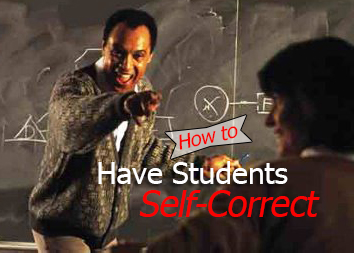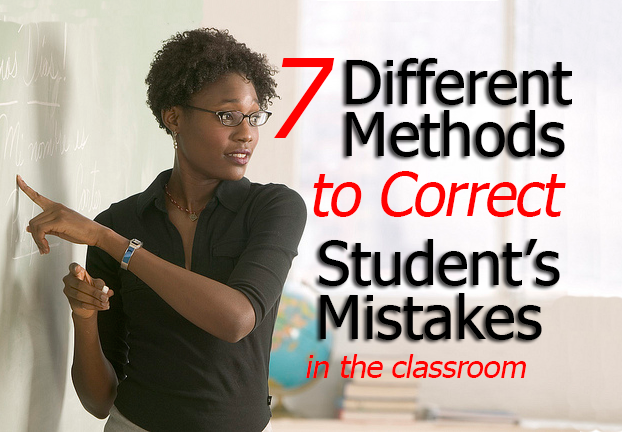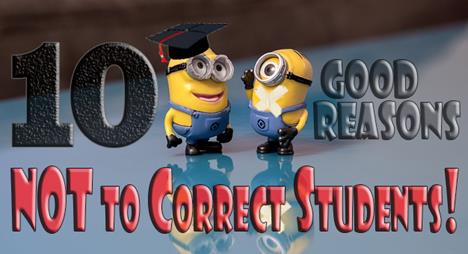Our students expect guidance and advice from us, they pay for it and hope that it can benefit their language ability. The biggest part of that expectation is that their teacher will correct them when they make mistakes. Too much error correction however can push a student into silence and the absence of it can cause students to grow suspicious of our performance. They might feel that we are not paying attention or simply do not care very much about doing our jobs well. In order to find the right balance between helping our students fix errors to improve their accuracy and providing an effective classroom environment that fosters confidence, safety and fluency we must make an important distinction then on when and when not to correct.
SET THE RIGHT ERROR CORRECTION ENVIRONMENT
Explain to the students that errors happen to everyone, even native speakers make errors all the time. Furthermore in class mistakes are a good thing! They create opportunities for the teacher and student to work together and make a difference for improving everyone’s English. Making mistakes in our classroom is expected and welcomed. The more mistakes you make in here (our safe classroom environment) the less mistakes you will make out their using your English in real world settings. Now, that is a good thing!
Keep it positive at all times! Saying “you almost got
that perfect” is better than “that was wrong”.
Inform your students on why and how you will correct. I like to tell them I am somewhat of a machine, a teaching and correcting machine. It’s my job and it is nothing personal at all. If I correct you in any way just hear the correction, repeat it, and keep on speaking! You never have to apologize or stop talking because of an error. Also I make sure everyone knows that if I am silent that means that everyone is doing a fantastic job with the day’s target language and my silence means their success.
WHEN TO ERROR CORRECT? – THE ARGUMENT
There is some subjectivity on when you should step in and correct. The benefits of correction are obvious, we can improve a student’s accuracy and help them to avoid fossilization of their mistakes. However there are disadvantages to consider. Interruptions by the teacher, however helpful, can stop the flow of activities, stifle student’s practice to speak fluently, and hurt student’s confidence. This is why I mentioned before an important distinction should be made on when and when not to correct. The rule I go by is simple.
Using previously learned material incorrectly is a
mistake and SHOULD be corrected, using material incorrectly
which has not yet been studied is an error and can be IGNORED.
We need to be vigilant and constantly on the lookout for mistakes in our students English rather than attempting to stop them, or our lesson activities, every time we hear an error. [Read deeper: 10 Good Reasons not to Correct Students] We should correct mistakes in various areas of our student’s produced language. Grammar, vocabulary choice, pronunciation of both words and correct stressing in sentences are the usual areas to monitor closely.
CORRECT DIFFERENTLY AT DIFFERENT STAGES OF YOUR LESSON
A good lesson takes a digestible language point (target language) and focuses on helping students understand it, practice with it, and finally produce that language point themselves through fun and interesting activities. Using these different stages in lessons also requires teachers to employ different strategies of error correction that compliment the different stages of the lesson plan well.
Using immediate or delayed correction,
correction from teacher to student or group to student,
as well as correcting actual student’s mistakes or
generating a list of expected mistakes beforehand
complement different stages of the lesson respectively.
In the early Practice stage of our lesson (restricted use of the target language) students are making short utterances by finishing off prompts or having short and simple exchanges working in pairs/groups. We should correct mistakes, teacher to student, as we hear them (hot correction). Hot correction in the early stages of our lesson will help support the student’s understanding of the target language and ensure correct usage as quickly as possible. This is also a good time to hand out (or put on the board) a list of common mistakes with this target language, pre-generated before the lesson by the teacher. Letting students correct these mistakes as a group can reinforce the correct usage of the target language and help to highlight the common pitfalls without singling students out for that error. This is also the stage to ignore errors made outside of the lesson’s target language.
Try to leave a written (or photographic) record
of common mistakes made and how they are corrected
for students to walk away with for self-study.
As our lesson matures into the later stage of Production (free use of the target language) then our error correction strategy should change to a delayed correction method so that students can focus on fluency while integrating the new target language with their entire pool of knowledge of English. Students will be engaging in group activities, role-plays, discussions, presentations and task based activities to help them do so. It is not a good strategy to stop the flow of the conversation in these kinds of activities by jumping in to correct, then expect the students to carry on where they left off. Teachers can make notes of mistakes they hear and present the mistakes in the final few minutes of the activity by writing them on the board and correcting them together as a class. This is the stage to broaden your working definition of mistake to cover today’s target language and previously learned target language points also. After invite students to take a picture of the corrections on the board or do so yourself and post it somewhere for student’s to access.
Correction needs to take place, it is expected, desired and valued by our students. However the success of a lesson plan and the growth of our student’s abilities can be drastically affected, both positively or negatively, on how we chose to correct in our classes. Setting up the right correction environment, knowing when to and when not to correct, using different correction techniques to compliment different stages of the lesson as well as leaving a record of correction for students to walk away with will tip the scales completely in favor of the positive.
Please share your thoughts and techniques on error correction in the comment section below for others to benefit from. Also feel free to share this post via the share buttons here on this page.






